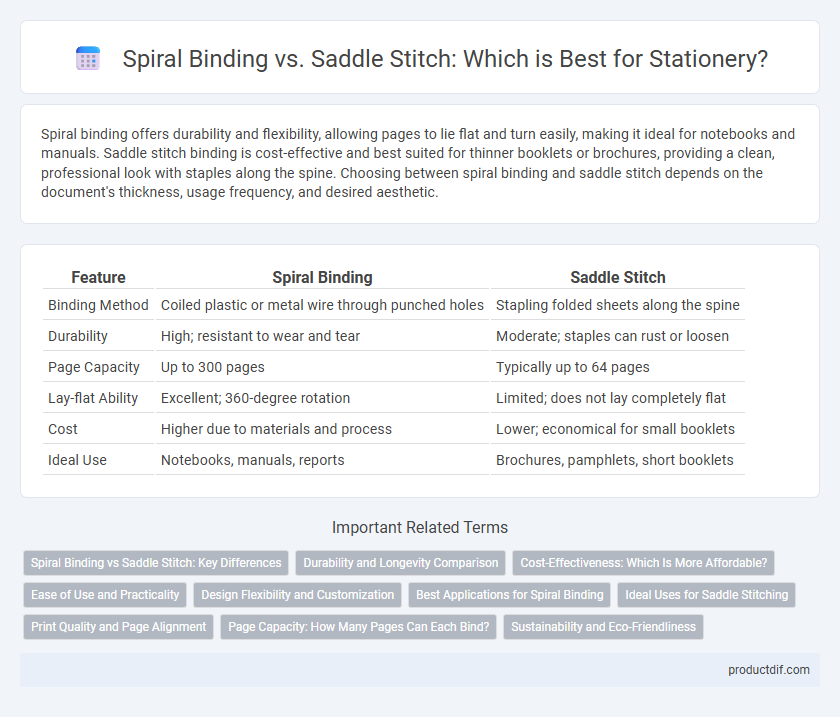Spiral binding offers durability and flexibility, allowing pages to lie flat and turn easily, making it ideal for notebooks and manuals. Saddle stitch binding is cost-effective and best suited for thinner booklets or brochures, providing a clean, professional look with staples along the spine. Choosing between spiral binding and saddle stitch depends on the document's thickness, usage frequency, and desired aesthetic.
Table of Comparison
| Feature | Spiral Binding | Saddle Stitch |
|---|---|---|
| Binding Method | Coiled plastic or metal wire through punched holes | Stapling folded sheets along the spine |
| Durability | High; resistant to wear and tear | Moderate; staples can rust or loosen |
| Page Capacity | Up to 300 pages | Typically up to 64 pages |
| Lay-flat Ability | Excellent; 360-degree rotation | Limited; does not lay completely flat |
| Cost | Higher due to materials and process | Lower; economical for small booklets |
| Ideal Use | Notebooks, manuals, reports | Brochures, pamphlets, short booklets |
Spiral Binding vs Saddle Stitch: Key Differences
Spiral binding uses a continuous metal or plastic coil threaded through punched holes along the document edge, offering 360-degree page rotation and durability for thicker booklets. Saddle stitch involves folding sheets and stapling them along the fold line, suited for thinner documents with lower page counts due to its limited capacity and flat spine. Spiral binding supports longer lifespan and ease of page turning, while saddle stitch provides a cost-effective solution for simple, smaller publications.
Durability and Longevity Comparison
Spiral binding offers superior durability and longevity compared to saddle stitch, as its plastic or metal coils securely hold thicker documents without risk of pages falling out. Saddle stitch is ideal for shorter booklets but tends to wear out faster due to staples that can loosen or rust over time. For documents requiring frequent use or longer shelf life, spiral binding provides enhanced structural integrity and sustained usability.
Cost-Effectiveness: Which Is More Affordable?
Spiral binding typically incurs higher costs due to its durable materials and customization options, making it ideal for thicker documents and professional presentations. Saddle stitch binding is more affordable for short booklets or brochures, using staple-based assembly that suits lower page counts and tight budgets. For cost-effectiveness, saddle stitch is the preferred choice for small print runs, while spiral binding is a better investment for longevity and volume.
Ease of Use and Practicality
Spiral binding offers superior ease of use by allowing pages to lay flat and rotate 360 degrees, making it practical for notebooks and manuals requiring frequent handling. Saddle stitch, while cost-effective and quick, limits page capacity and is best suited for smaller booklets or brochures. The choice depends on project size and user interaction, with spiral binding excelling in durability and usability for extensive content.
Design Flexibility and Customization
Spiral binding offers superior design flexibility with the ability to accommodate thicker documents and incorporate personalized covers, making it ideal for customized projects. Saddle stitch is limited to thinner booklets but allows for economical customization through varied paper types and finishes. Choosing between these binding methods depends on the desired durability, page count, and visual presentation.
Best Applications for Spiral Binding
Spiral binding is ideal for documents requiring durability and easy page turning, such as notebooks, manuals, and presentations. It supports a wide range of paper sizes and thicknesses, allowing the pages to lie flat or be folded back without damage. This binding method is preferred for professional reports and educational materials that demand frequent handling.
Ideal Uses for Saddle Stitching
Saddle stitching is ideal for booklets, brochures, and magazines with a lower page count, typically up to 64 pages, where cost-efficiency and quick turnaround are priorities. This binding method offers a flat lay when open, making it perfect for marketing materials and catalogs that require easy reading and stapled edges. Its suitability for thin documents ensures a professional finish without the bulk of more complex bindings like spiral or perfect binding.
Print Quality and Page Alignment
Spiral binding offers superior print quality and precise page alignment by allowing each page to lay completely flat, minimizing distortion and ensuring consistent margins throughout the document. Saddle stitch, while cost-effective, may cause slight misalignment and page warping near the staples, potentially affecting the clarity of printed images and text. Choosing spiral binding enhances professional presentation and readability in multi-page documents.
Page Capacity: How Many Pages Can Each Bind?
Spiral binding accommodates a significantly higher page capacity, typically holding anywhere from 20 to over 300 pages, making it suitable for thick documents like notebooks or manuals. Saddle stitch binding, on the other hand, is ideal for thinner booklets, effectively binding up to 64 pages, as it involves folding sheets and stapling them along the spine. Choosing between these binding types depends on the volume of pages and the durability required for the final product.
Sustainability and Eco-Friendliness
Spiral binding often uses plastic coils which can be less environmentally friendly compared to saddle stitch, which utilizes staple wires and minimal materials. Saddle stitch produces less waste and is more easily recyclable, making it a preferred choice for eco-conscious businesses seeking sustainable stationery solutions. Choosing saddle stitch over spiral binding supports lower carbon footprints and reduces landfill impact due to its simpler, biodegradable components.
Spiral Binding vs Saddle Stitch Infographic

 productdif.com
productdif.com